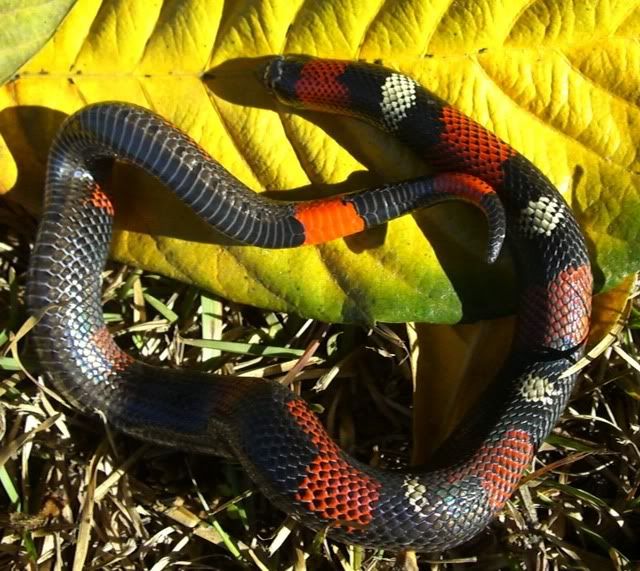Sort of Hijack...Then Back On Topic
tyflier said:
Coral snakes are venomous. If you eat one, nothing happens...
I'm a little confused about my toad, Olivia. She secretes "venom," (it's called that everywhere) but if a dog or whatever licks her, it gets poisoned. She has two things:
Bufotenin (also known as bufotenine), is a tryptamine related to the neurotransmitter serotonin. It is an alkaloid found in the skin of some species of toads; in mushrooms, higher plants, and mammals; and possibly in the brain, plasma, and urine of schizophrenics.
The name bufotenin originates from the Bufo genus of toads, which includes several species of psychoactive toads (such as Bufo alvarius and Bufo marinus) that secrete bufotoxins from their parotoid glands. Bufotenin is very similar in chemical structure to the hallucinogen psilocin; the only structural difference is that the hydroxyl (-OH) group is located one carbon over on the indole ring. However, pharmacologically, it is more closely related to 5-MeO-DMT and DMT,[citation needed] chemicals that often occur in plant and animal species in which bufotenin is found. Whether bufotenine is also hallucingenic has been the subject of debate among researchers.
She also has 5-MeO-DMT:
5-MeO-DMT was first synthesized in 1936, and in 1959 it was isolated as one of the psychoactive ingredients of Anadenanthera peregrina seeds used in preparing Yopo snuff. It was once believed to be a major player in the psychoactive effects of the snuff. However, recent tests confirm that bufotenin is the main active psychoactive ingredient of Yopo and that DMT and 5-MeO-DMT are present in quantities too small to elicit much effects. It occurs in many organisms that contain bufotenin(e) (5-hydroxy-DMT), and is the O-methyl analogue of that compound.
Traditionally 5-MeO-DMT has been used in psychedelic snuff made from Virola bark resin, and may be a trace constituent of ayahuasca when plants such as Diplopterys cabrerana are used as an admixture. 5-MeO-DMT is also found in the venom of the Colorado River Toad (Bufo alvarius), although there is no direct evidence this was used as a hallucinogen until recent times.
Use and effects: When used as a drug in its purified form, 5-MeO-DMT is smoked, insufflated, or injected and is active at a dose of as little as 2 mg. 5-MeO-DMT is also active orally, when taken with an monoamine oxidase inhibitor, but according to numerous reports, the combination with MAOI is extremely unpleasant and has a strong body-load. According to the researcher Jonathan Ott, 5-MeO-DMT is active orally with doses over 30 mg without aid of a MAOI.
The onset of effects occurs in seconds after smoking/injecting, or minutes after insufflating, and the experience is sometimes described as similar to a near-death experience. Peak effects last for approximately 5-10 minutes, when smoked. When insufflated, the peak effects are considerably less intense, but last for 15-25 minutes on average.
Although similar in many respects to its close relatives DMT and bufotenin (5-OH-DMT), the effects are typically not as visual. Some users report experiencing no visual effects from it even at very high doses.
Ok, Back on subject:
Inez the Nelson's Milk is a very poor cornsnake substitute!
Zee is much calmer, but you definitely wouldn't mistake him for a Coral, though in South America various tri-colored hoggies are often referred to as False Coral Snakes.
Nanci



